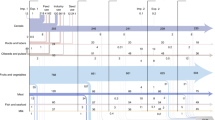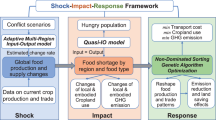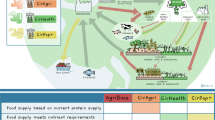Abstract
Global food loss and waste continues to increase despite efforts to reduce it. Food waste causes a disproportionally large carbon footprint and resource burdens, which require urgent action to transition away from a disposal-dominated linear system to a circular bioeconomy of recovery and reuse of valuable resources. Here, using data from field-based studies conducted under diverse conditions worldwide, we found collective evidence that composting, anaerobic digestion and repurposing food waste to animal feed (re-feed) result in emission reductions of about 1 tCO2e t−1 food waste recycled compared with landfill disposal. Emission mitigation capacity resulting from no landfill disposal in the United States, the European Union and China would average 39, 20 and 115 MtCO2e, which could offset 10%, 5% and 17% of the emissions from these large agricultural systems, respectively. In addition, re-feed could spare enormous amounts of land, water, agricultural fuel and fertilizer use. Our findings provide a benchmark for countries developing food waste management strategies for a circular agrifood system.
This is a preview of subscription content, access via your institution
Access options
Access Nature and 54 other Nature Portfolio journals
Get Nature+, our best-value online-access subscription
$32.99 / 30 days
cancel any time
Subscribe to this journal
Receive 12 digital issues and online access to articles
$119.00 per year
only $9.92 per issue
Buy this article
- Purchase on SpringerLink
- Instant access to full article PDF
Prices may be subject to local taxes which are calculated during checkout



Similar content being viewed by others
Data availability
The source data for the bootstrapping analyses used to compute the means and 95% CIs of the carbon footprints of the food waste treatments, landfill emissions and product metrics and for the impact analysis of the food waste management schemes of the United States, the EU and China are available on Zenodo at https://doi.org/10.5281/zenodo.14826061 (ref. 81). All other data that support the findings of this study are provided in the article. Source data are provided with this paper.
Code availability
The code used in the Stata statistical analysis is available on Zenodo at https://doi.org/10.5281/zenodo.14826061 (ref. 81).
References
Clark, M. A., Domingo, N., Colgan, K., Thakrar, S. K. & Hill, J. D. Global food system emissions could preclude achieving the 1.5° and 2 °C climate change targets. Science 370, 705–708 (2020).
UAE Declaration on Sustainable Agriculture, Resilient Food Systems, and Climate Action (COP28, 2023); https://www.cop28.com/en/food-and-agriculture
The State of Food and Agriculture: Revealing the True Cost of Food to Transform Agrifood Systems (FAO, 2023); https://www.fao.org/3/cc7724en/cc7724en.pdf
Rosenzweig, C. et al. Climate change responses benefit from a global food system approach. Nat. Food 1, 94–97 (2020).
Zurek, M., Hebinck, A. & Selomane, O. Climate change and the urgency to transform food systems. Science 376, 1416–1421 (2022).
Gatto, A. & Chepeliev, M. Global food loss and waste estimates show increasing nutritional and environmental pressures. Nat. Food 5, 136–147 (2024).
Wang, X. et al. Global food nutrients analysis reveals alarming gaps and daunting challenges. Nat. Food 4, 1007–1017 (2023).
Crippa, M. et al. Food systems are responsible for a third of global anthropogenic GHG emissions. Nat. Food 2, 198–209 (2021).
Tubiello, F. N. et al. Pre- and post-production processes increasingly dominate greenhouse gas emissions from agri-food systems. Earth Syst. Sci. Data 14, 1795–1809 (2022).
Zhu, J. et al. Cradle-to-grave emissions from food loss and waste represent half of total greenhouse gas emissions from food systems. Nat. Food 4, 247–256 (2023).
What a Waste 2.0: A Global Snapshot of Solid Waste Management to 2050 (World Bank, 2018); https://elibrary.worldbank.org/doi/pdf/10.1596/978-1-4648-1329-0
Methane and Climate Change (International Energy Agency, 2024); https://www.iea.org/reports/methane-tracker-2021/methane-and-climate-change
Richardson, K. et al. Earth beyond six of nine planetary boundaries. Sci. Adv. 9, eadh2458 (2023).
Dou, Z. & Toth, J. D. Global primary data on consumer food waste: rate and characteristics—a review. Resour. Conserv. Recycl. 168, 105332 (2020).
Dou, Z., Dierenfeld, E. S., Wang, X., Chen, X. & Shurson, G. C. A critical analysis of challenges and opportunities for upcycling food waste to animal feed to reduce climate and resource burdens. Resour. Conserv. Recycl. 203, 107418 (2024).
Shurson, G. C., Dierenfeld, E. S. & Dou, Z. Rules are meant to be broken—rethinking the regulations on the use of food waste as animal feed. Resour. Conserv. Recycl. 199, 107273 (2023).
Spang, E. S. et al. Food loss and waste: measurement, drivers, and solutions. Annu. Rev. Environ. Resour. 44, 117–156 (2019).
Pinotti, L. et al. Recycling food leftovers in feed as opportunity to increase the sustainability of livestock production. J. Clean. Prod. 294, 126290 (2021).
Westendorf, M. Food Waste as Animal Feed: An Introduction (John Wiley & Sons, 2000).
zu Ermgassen, E. K., Phalan, B., Green, R. E. & Balmford, A. Reducing the land use of EU pork production: where there’s swill, there’s a way. Food Policy 58, 35–48 (2016).
Awasthi, S. K. et al. Changes in global trends in food waste composting: research challenges and opportunities. Bioresour. Technol. 299, 122555 (2020).
Blengini, G. A. Using LCA to evaluate impacts and resources conservation potential of composting: a case study of the Asti District in Italy. Resour. Conserv. Recycl. 52, 1373–1381 (2008).
Bong, C. P. C. et al. The characterisation and treatment of food waste for improvement of biogas production during anaerobic digestion—a review. J. Clean. Prod. 172, 1545–1558 (2018).
Kim, M. H., Song, H. B. & Song, Y. Evaluation of food waste disposal options in terms of global warming and energy recovery: Korea. Int. J. Energy Environ. Eng. 4, 1 (2013).
Baker, L. et al. Leveraging dairy cattle to upcycle culled citrus fruit for emission mitigation and resource co-benefits: a case study. Resour. Conserv. Recycl. 203, 107452 (2024).
Nakaishi, T. & Takayabu, H. Production efficiency of animal feed obtained from food waste in Japan. Environ. Sci. Pollut. Res. Int. 29, 61187–61203 (2022).
Pinotti, L. et al. Pig-based bioconversion: the use of former food products to keep nutrients in the food chain. Animal 17, 100918 (2023).
Latka, C. et al. Competing for food waste—policies’ market feedbacks imply sustainability tradeoffs. Resour. Conserv. Recycl. 186, 106545 (2022).
Cusworth, D. H. et al. Quantifying methane emissions from United States landfills. Science 383, 1499–1504 (2024).
Guidelines for National Greenhouse Gas Inventories (IPCC, 2006); https://www.ipcc.ch/report/2006-ipcc-guidelines-for-national-greenhouse-gas-inventories/
Cherubini, F., Bargigli, S. & Ulgiati, S. Life cycle assessment (LCA) of waste management strategies: landfilling, sorting plant and incineration. Energy 34, 2116–2123 (2009).
Eriksson, M., Strid, I. & Hansson, P.-A. Carbon footprint of food waste management options in the waste hierarchy—a Swedish case study. J. Clean. Prod. 93, 115–125 (2015).
Gómez-Sanabria, A., Kiesewetter, G., Klimont, Z., Schoepp, W. & Haberl, H. Potential for future reductions of global GHG and air pollutants from circular waste management systems. Nat. Commun. 13, 106 (2022).
Shukla, K. A. et al. Food waste management and sustainable waste to energy: current efforts, anaerobic digestion, incinerator and hydrothermal carbonization with a focus in Malaysia. J. Clean. Prod. 448, 141457 (2024).
Ruminant Methanogens as a Climate Change Target (American Society of Microbiology, 2023); https://asm.org/Articles/2023/June/Ruminant-Methanogens-as-a-Climate-Change-Target
(USDA National Agricultural Statistics Service, 2024); https://www.nass.usda.gov/Newsroom/
Govoni, C., D’Odorico, P., Pinotti, L. & Rulli, M. C. Preserving global land and water resources through the replacement of livestock feed crops with agricultural by-products. Nat. Food 4, 1047–1057 (2023).
Karlsson, J. O., Parodi, A., van Zanten, H. H. E., Hansson, P.-A. & Röös, E. Halting European Union soybean feed imports favours ruminants over pigs and poultry. Nat. Food 2, 38–46 (2020).
Liu, Z. et al. Optimization of China’s maize and soy production can ensure feed sufficiency at lower nitrogen and carbon footprints. Nat. Food 2, 426–433 (2021).
SDG Target 12.3 on Food Loss and Waste: 2022 Progress Report (World Resources Institute, 2022); https://champions123.org/publication/sdg-target-123-food-loss-and-waste-2022-progress-report
Driven to Waste: The Global Impact of Food Loss and Waste on Farms (World Wildlife Fund, 2021); https://www.worldwildlife.org/publications/driven-to-waste-the-global-impact-of-food-loss-and-waste-on-farms
Gustavsson, J., Cederberg, C., Sonesson, U., Van Otterdijk, R. & Meybeck, A. Global Food Losses and Food Waste: Extent, Causes and Prevention (FAO, 2011).
SDG Target 12.3 on Food Loss and Waste: 2023 Progress Report (World Resources Institute, 2023); https://champions123.org/sites/default/files/2023-10/2023%20Champions%20Progress%20Report.pdf
SDG Target 12.3 on Food Loss and Waste: 2024 Progress Report (World Resources Institute, 2024); https://champions123.org/2024-progress-report
Mourad, M. Recycling, recovering and preventing “food waste”: competing solutions for food systems sustainability in the United States and France. J. Clean. Prod. 126, 461–477 (2016).
Shigetomi, Y., Ishigami, A., Long, Y. & Chapman, A. Curbing household food waste and associated climate change impacts in an ageing society. Nat. Commun. 15, 8806 (2024).
Stancu, V., Haugaard, P. & Lähteenmäki, L. Determinants of consumer food waste behaviour: two routes to food waste. Appetite 96, 7–17 (2016).
Aye, L. & Widjaya, E. R. Environmental and economic analyses of waste disposal options for traditional markets in Indonesia. Waste Manage. 26, 1180–1191 (2006).
Takata, M. et al. The effects of recycling loops in food waste management in Japan: based on the environmental and economic evaluation of food recycling. Sci. Total Environ. 432, 309–317 (2012).
Quirós, R. et al. Environmental assessment of two home composts with high and low gaseous emissions of the composting process. Resour. Conserv. Recycl. 90, 9–20 (2014).
Berglund, M. & Börjesson, P. Assessment of energy performance in the life-cycle of biogas production. Biomass Bioenergy 30, 254–266 (2006).
Fontaine, J., Hörr, J. & Schirmer, B. Near-infrared reflectance spectroscopy enables the fast and accurate prediction of the essential amino acid contents in soy, rapeseed meal, sunflower meal, peas, fishmeal, meat meal products, and poultry meal. J. Agric. Food Chem. 49, 57–66 (2001).
Noel, S. J., Jørgensen, H. J. H. & Knudsen, K. E. B. Prediction of protein and amino acid composition and digestibility in individual feedstuffs and mixed diets for pigs using near-infrared spectroscopy. Anim. Nutr. 7, 1242–1252 (2021).
Wang, Y. et al. Evidence of animal productivity outcomes when fed diets including food waste: a systematic review of global primary data. Resour. Conserv. Recycl. 203, 107411 (2024).
Shurson, G. C. et al. New perspectives for evaluating relative risks of African swine fever virus contamination in global feed ingredient supply chains. Transbound. Emerg. Dis. 69, 31–56 (2022).
Shurson, G. C. “What a waste”—can we improve sustainability of food animal production systems by recycling food waste streams into animal feed in an era of health, climate, and economic crises? Sustainability 12, 7071 (2020).
Shurson, G. C., Urriola, P. E. & Ligt, J. L. G. Can we effectively manage parasites, prions, and pathogens in the global feed industry to achieve One Health? Transbound. Emerg. Dis. 69, 4–30 (2021).
Balestreri, C. et al. Unexpected thermal stability of two enveloped megaviruses, Emiliania huxleyi virus and African swine fever virus, as measured by viability PCR. Virol. J. 21, 1 (2024).
Mazur-Panasiuk, N., Żmudzki, J. & Woźniakowski, G. African swine fever virus—persistence in different environmental conditions and the possibility of its indirect transmission. J. Vet. Res. 63, 303–310 (2019).
Taylor, D. Inactivation of transmissible degenerative encephalopathy agents: a review. Vet. J. 159, 10–17 (2000).
Georganas, A. et al. Redefining the future of catering waste application in animal diets—a review on the minimization of potential hazards in catering waste prior to application in animal diets. Anim. Feed Sci. Technol. 289, 115334 (2022).
Eco-feed (Ministry of Agriculture, Forestry and Fisheries of Japan, 2024); https://www.maff.go.jp/j/chikusan/sinko/lin/l_siryo/ecofeed.html
Food Conservation Action Plan (Ministry of Agriculture and Rural Affairs of China, accessed 3 November 2021); http://www.moa.gov.cn/gk/zcfg/xzfg/202111/t20211103_6381159.htm
James, K., Millington, A. & Randall, N. Food and Feed Safety Vulnerabilities in the Circular Economy (EFSA, 2022).
Elleby, C., Jensen, H. G., Domínguez, I. P., Chatzopoulos, T. & Charlebois, P. Insects reared on food waste: a game changer for global agricultural feed markets? EuroChoices 20, 56–62 (2021).
Mlambo, V. et al. Rethinking food waste: exploring a black soldier fly larvae-based upcycling strategy for sustainable poultry production. Resour. Conserv. Recycl. 199, 107284 (2023).
Pinotti, L., Giromini, C., Ottoboni, M., Tretola, M. & Marchis, D. Insects and former foodstuffs for upgrading food waste biomasses/streams to feed ingredients for farm animals. Animal 13, 1365–1375 (2019).
Wehrens, R., Putter, H. & Buydens, L. The bootstrap: a tutorial. Chemom. Intell. Lab. Syst. 54, 35–52 (2000).
Wang, H. et al. Yield and water productivity of crops, vegetables and fruits under subsurface drip irrigation: a global meta-analysis. Agric. Water Manage. 269, 107645 (2022).
Food: Material-Specific Data (US Environmental Protection Agency, 2023); https://www.epa.gov/facts-and-figures-about-materials-waste-and-recycling/food-material-specific-data
Food Waste and Food Waste Prevention by NACE Rev. 2 Activity—Tonnes of Fresh Mass (Eurostat, 2023); https://ec.europa.eu/eurostat/web/main/data/database
Xue, L. et al. China’s food loss and waste embodies increasing environmental impacts. Nat. Food 2, 519–528 (2021).
Padeyanda, Y., Jang, Y.-C., Ko, Y. & Yi, S. Evaluation of environmental impacts of food waste management by material flow analysis (MFA) and life cycle assessment (LCA). J. Mater. Cycles Waste 18, 493–508 (2016).
Ritchie, H., Rosado, P. & Roser, M. CO2 and greenhouse gas emissions (Our World in Data, 2023); https://ourworldindata.org/co2-and-greenhouse-gas-emissions
Kamopas, W. & Kiatsiriroat, T. Regeneration of mono-ethanolamine solution after biogas purification by electrical heating with assisted ultrasonic wave. Waste Biomass Valorization 10, 3879–3884 (2018).
Fung, L., Urriola, P. E., Baker, L. & Shurson, G. C. Estimated energy and nutrient composition of different sources of food waste and their potential for use in sustainable swine feeding programs. Transl. Anim. Sci. 3, 359–368 (2019).
Fung, L., Urriola, P. E. & Shurson, G. C. Energy, amino acid, and phosphorus digestibility and energy prediction of thermally processed food waste sources for swine. Transl. Anim. Sci. 3, 676–691 (2019).
Jinno, C. et al. Enzymatic digestion turns food waste into feed for growing pigs. Anim. Feed Sci. Technol. 242, 48–58 (2018).
Heuzé, V., Tran, G., Bastianelli, D. & Lebas, F. Animal feed resources information system (Feedipedia, 2023); https://www.feedipedia.org/
FAOSTAT (FAO, 2020); http://www.fao.org/faostat/zh/#data
Wang, Y. Supplemental information of “Food waste utilized as resources can reduce climate and resource burdens in agrifood systems”. Zenodo https://doi.org/10.5281/zenodo.14826061 (2025).
Acknowledgements
This work was supported by the National Key Research and Development Program of China (2022YFD1901501, 2021YFD1901001, H.Y.), the Major Science and Technology Project of Yunnan Province (202202AE090034, H.Y.), the Major Science and Technology Project of Shandong Province (2023TZXD088, 2024CXPT075, Z.C.) and Natural Science Foundation of Zhejiang Province, China (number LY22E080009, T.C.). This study also received funding from the following sources: University of Pennsylvania Global Engagement (Z.D.), Pennsylvania Department of Agriculture (Z.D.) and USDA-NIFA IDEAS Program (number 2022-68014-36664, project accession number 1028184; Z.D.).
Author information
Authors and Affiliations
Contributions
Z.D. and Z.C. designed and directed the study. Z.W., Y.Y., H.Z. and T.N. contributed to the literature search and data acquisition. T.C. and J.L. participated in project planning and discussion. D.S. conducted bootstrapping and Monte Carlo statistical simulations and analysis, wrote the description of the statistical methods, and reviewed the results. Z.D., Y.W., H.Y. and Z.C. collaborated on data management and organization and paper development. Z.D. and Y.W. wrote the paper, and G.C.S. contributed to the paper review, editing and revision. All authors contributed to the discussion of the study and development of the paper.
Corresponding authors
Ethics declarations
Competing interests
The authors declare no competing interests.
Peer review
Peer review information
Nature Food thanks Prajal Pradhan and the other, anonymous, reviewer(s) for their contribution to the peer review of this work.
Additional information
Publisher’s note Springer Nature remains neutral with regard to jurisdictional claims in published maps and institutional affiliations.
Extended data
Extended Data Fig. 1 Flow chart of literature search and selection processes for studies on food waste treatment via aerobic composting (AC), anaerobic digestion (AD), re-purposing to animal feed (Re-Feed), or landfill disposal, in terms of greenhouse gas (GHG) emissions and product for recycling-reuse.
Of 91 studies selected, 50 included two or more food waste treatment methods.
Extended Data Fig. 2 The system starts with food waste collection and coupled with transport, then followed by processing, and ends with the production of the final product.
Standardized system boundaries to cover food waste collection, transport, and processing through AC, AD, or Re-Feed.
Supplementary information
Supplementary Information
Supplementary Tables 1–3.
Source data
Source Data Fig. 1
Source data for Fig. 1.
Source Data Fig. 2
Source data for Fig. 2.
Source Data Fig. 3
Source data for Fig. 3.
Rights and permissions
Springer Nature or its licensor (e.g. a society or other partner) holds exclusive rights to this article under a publishing agreement with the author(s) or other rightsholder(s); author self-archiving of the accepted manuscript version of this article is solely governed by the terms of such publishing agreement and applicable law.
About this article
Cite this article
Wang, Y., Ying, H., Stefanovski, D. et al. Food waste used as a resource can reduce climate and resource burdens in agrifood systems. Nat Food 6, 478–490 (2025). https://doi.org/10.1038/s43016-025-01140-z
Received:
Accepted:
Published:
Issue date:
DOI: https://doi.org/10.1038/s43016-025-01140-z
This article is cited by
-
Turning food waste into climate solutions
Nature Food (2025)
-
Beyond landfills: transforming biodegradable waste into climate solutions and valuable resources
Reviews in Environmental Science and Bio/Technology (2025)



